Battle for Tikrit key to Iraq's future
- Published
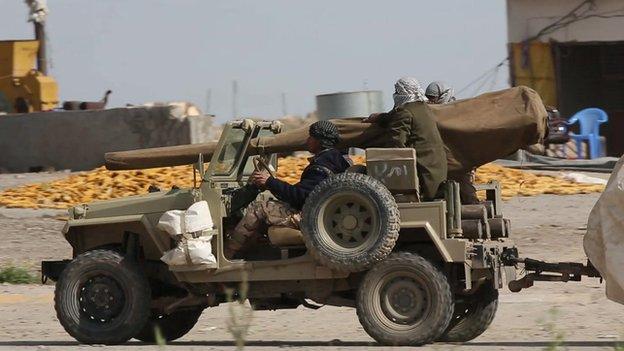
Tikrit is now surrounded
Last week Iraqi defence officials and Shia military commanders were confidently predicting the fall of Tikrit within a matter of days.
But the city centre is still in the hands of Islamic State (IS) fighters, despite being bombarded for more than a fortnight.
At one of the main roads into the city, it is now strangely silent - interrupted only by the occasional burst of small arms fire.
It looks like a stalemate with the Shia-led militia on one side and IS fighters dug into defensive positions on the other, within the city itself.
Driving with the commander of the Shia Badr Brigade, Hadi Al-Amiri, towards the frontline, we passed the areas recently recaptured, by the so-called Popular Mobilisation Units.
They don't like the label Shia militia and say that Sunnis opposed to IS are joining in their fight.
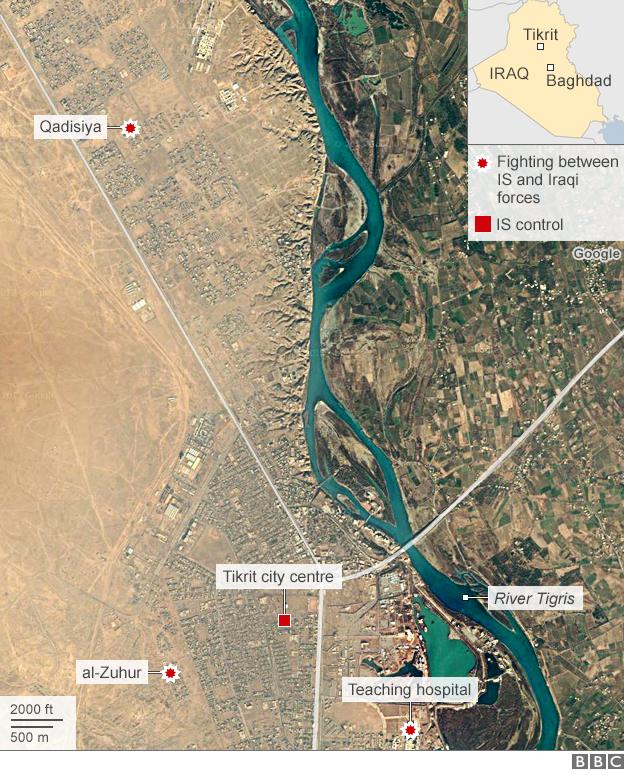
We witnessed a trail of destruction.
There are allegations that the Shia militia themselves caused some of the damage with "revenge attacks" on the mostly Sunni villages that surround the city.
But there is also evidence of a determined enemy.
There was the mangled wreckage of armoured vehicles and cars - some the burnt-out debris of one of IS's favoured weapons of choice, the suicide bomber.
Hadi Al-Amiri said there had be 15 such attacks on this one road.
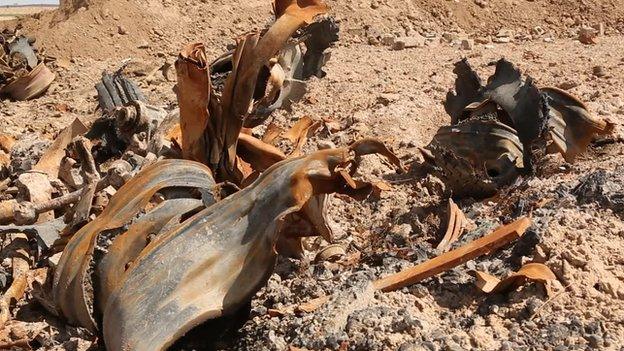
Wreckage from a suicide bombing
At the city limits, just out of the range of IS snipers, the Badr Brigade commander pulled out a map showing how the city was now surrounded.
"We are not in a hurry," he said, denying the offensive had stalled.
His militia were, he said, killing lots of extremists every day as well as destroying their supplies. "The longer it goes on the weaker they will become," he said.
He was equally dismissive of any suggestion he needed help.
Iranian aid
In reality he is already getting it from Iran, which is providing weapons and military advice.
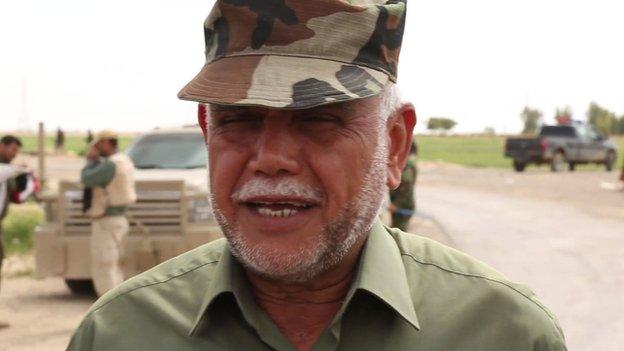
Hadi Al-Amiri leads the Badr Brigade
The operation is being co-ordinated from the shadows by Gen Qasem Suleimani of the Quds Force, an elite division of the Iranian Revolutionary Guard.
The "ghost" general, external has been on the frontline, but is rarely seen.
Hadi Al-Amiri has welcomed his advice, but said he did not want US airstrikes. Only "weak people like the Iraqi army" wanted US help, he said.
The Shia militia's relationship with Iran is a worry for Washington, which sees it as potentially destabilising and deepening Iraq's sectarian divide.
Elsewhere in Iraq and Syria US-led airstrikes may have - in the words of the head of the CIA John Brennan - "blunted", external the IS advance.
But there is a limit to what they can achieve.
Since 8 August 2014 there have been 2,320 airstrikes, destroying 73 tanks, 282 armoured vehicles and hitting more than 1,000 IS positions.
The operation has already cost the Pentagon nearly $2bn ($1.3bn).
Rebuilding an army
It will take more than airstrikes to dislodge IS from Iraq's towns and cities.
There are also fears that, if used, they could cause civilian casualties and reduce cities to rubble.

Operation Inherent Resolve:
Targets damaged/destroyed (to 18 March 2015)
Tanks: 73
High mobility multipurpose wheeled vehicles: 282
Staging areas: 408
Buildings: 1,652
Fighting positions: 1,003
Oil collection points and refineries: 151
Other targets: 1,745
Source: Centcom

Iraq could ill afford to repair damaged infrastructure.
Meanwhile, the Americans and their coalition partners are helping to rebuild the Iraqi Army.
So far, in the battle for Tikrit, it has largely been on the sidelines.
But at a military base near the capital Baghdad Iraqi soldiers were being trained by US and Spanish forces in urban warfare, smashing down doors and learning how to clear buildings from enemy forces.
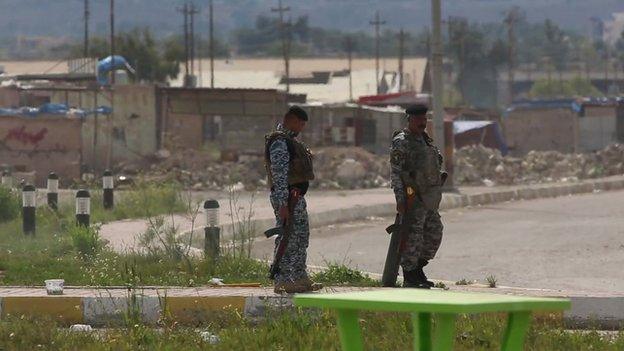
The road to Tikrit is eerily quiet
Many of the same Iraqi soldiers we watched being trained had fled when IS first entered the country. They say they were only following orders.
One task is to "increase their will to fight", says Col Julio Salom of the Spanish Legion, who is leading the training mission.
Sectarian divide
But the Spanish and Americans have been given just six weeks to train a unit of about 1,000 men.
The lengthy process of translation after each exercise does not make their job any easier.
Iraq needs a strong army, made up of Shia and Sunni, not just to defeat IS but also to heal the country's deep sectarian divide.
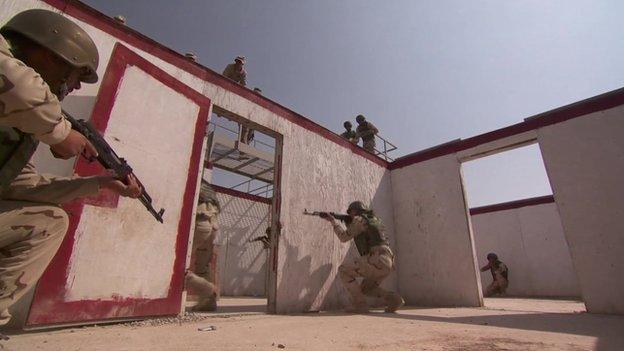
The Iraqi army is in intensive training
The signs are not good.
On a recent visit to Baghdad the US's most senior military commander, General Martin Dempsey, said he had a "déjà vu" feeling, external, seeing a "plethora of flags" but few bearing the flag of Iraq.
He has said some Iraqi army soldiers are not turning up to training, or have not been paid or properly equipped.
For now, in Tikrit, it is the Shia-led militia who are doing much of the fighting and dying.
The Badr Brigade, one of the strongest militia, has already lost more than 1,000 men.
Dozens of the photographs of these "martyrs" were on show at a memorial service in a Baghdad mosque attended by comrades in arms and the weeping mothers, widows and children they have left behind.
There will be more grieving to come.
To turn the tide against IS, Iraq must now recaptureTikrit.
Challenge ahead
It is the country's first big military test.
Without taking Tikrit it is hard to see how they will dislodge IS from Anbar and beyond.
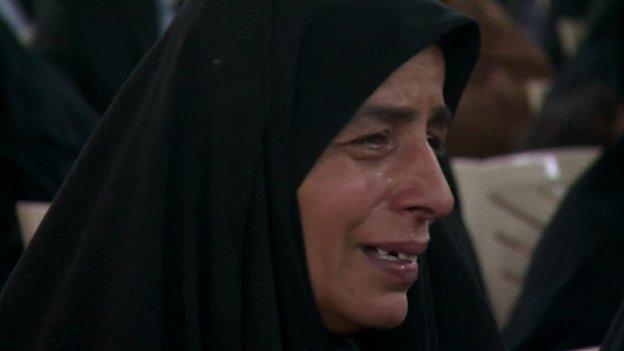
A widow of a fallen Shia militia member
Talk of a spring offensive on Mosul now looks optimistic.
And even if it can defeat IS, Iraq still needs to heal its sectarian divide.
In the words of Iraq's vice-president Ayad Allawi, Iraq needs more than just a military victory, it needs a political one too.